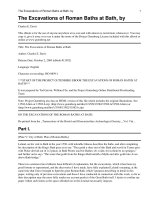Work life imbalance of remittance employees at bank a
Bạn đang xem bản rút gọn của tài liệu. Xem và tải ngay bản đầy đủ của tài liệu tại đây (4.14 MB, 53 trang )
UNIVERSITY OF ECONOMICS HO CHI MINH CITY
International School of Business
------------------------------
Nguyen Thi Phuong Oanh
WORK-LIFE IMBALANCE OF
REMITTANCE EMPLOYEES
AT BANK A
MASTER OF BUSINESS ADMINISTRATION
SUPERVISOR: Dr. Nguyen Phong Nguyen
Ho Chi Minh City - 2017
TABLE OF CONTENTS
LIST OF FIGURES..................................................................................................................................3
LIST OF TABLES ...................................................................................................................................3
EXECUTIVE SUMMARY ....................................................................................................................1
1. BACKGROUND ................................................................................................................................2
1.1.
Company Background ...........................................................................................................2
1.2.
Description of Remittance team ............................................................................................2
1.3.
Symptoms ................................................................................................................................4
1.3.1.
Long working hours .......................................................................................................4
1.3.2.
Increased health problems.............................................................................................5
1.3.3.
Decreased productivity ..................................................................................................6
1.4.
Initial cause-effect map ..........................................................................................................7
2. PROBLEM IDENTIFICATION ................................................................................................... 12
2.1. Situation analysis ...................................................................................................................... 12
3. CENTRAL PROBLEM VALIDATION ....................................................................................... 14
3.1. Central problem definition ...................................................................................................... 14
3.2. Central problem existence ....................................................................................................... 14
3.3. Central problem importance ................................................................................................... 16
5. SOLUTIONS AND ACTION PLANS ........................................................................................... 22
5.1. Individual aspects ..................................................................................................................... 22
5.2. Organizational aspects ............................................................................................................. 23
6. CONCLUSION ................................................................................................................................ 25
7. SUPPORTING INFORMATION .................................................................................................. 26
7.1. Interview guide ......................................................................................................................... 26
7.2. Transcripts ................................................................................................................................ 28
7.3. Questionnaire on Work-life imbalance .................................................................................. 40
8. REFERENCES ................................................................................................................................ 47
LIST OF FIGURES
Figure 1. Structure of Remittance team
Figure 2. Working hours of Remittance team
Figure 3. Productivity of Remittance team
Figure 4. Initial cause-effect map
Figure 5. Updated cause-effect map
Figure 6. Level of fatigue related workplace problems vs overtime level
Figure 7. Priority factors choosing a job
Figure 8. Second updated cause-effect map
Figure 9. Final cause-effect map
LIST OF TABLES
Table 1. Number of employees at grade A health results versus amount of
employees from 2015 to 2017
Table 2. Rate of employees sick leaving over 3 years (2015-2017)
Table 3. Interview guide questions of group 1
Table 4. Interview guide questions of group 2
LIST OF ABBREVIATIONS
Rem – Remittance
WLB – Work-life balance
EXECUTIVE SUMMARY
Each organization has its own problems. Depending on the seriousness of the
problems, the performance or even the survival of the organizations in this highly
competitive environment will be determined. In problem solving, identify the real
problem – the central problem is the most important step. The right problem
needed to be determined to propose the right solutions. Mistakes in determining the
real problem may result in unnecessary wastes of resources.
Therefore, this study focused on a specific of a department to have a deep look
of one problem. Starting with the symptoms as long working hours, increased
health problems and low productivity, the author managed to identify the central
problem by root case analysis method. Then, based on literature reviews and
surveys, it was recognized that Work-life imbalance is the central problem of this
organization.
Work-life imbalance is an attractive topic to discuss on both business and
academic research. Malgorzata Kluczyk (1) demonstrated that “work-life imbalance
is a central issue affecting wellbeing, as family and work are the most important
elements of everyone’s life”. The value of this study is through analysis of the
problems and the importance of it to suggest the best solutions for bank A practice.
It is useful for not only this bank manager but also all employees to find the right
way at their workplace.
1|Page
1. BACKGROUND
1.1. Company Background
For over 20 years since its initial branch in Vietnam in 1995, bank A has nearly
200 employees up to now. Among the flourish of banking industry, bank A is
facing with many competitors such as HSBC, Standard Chartered and a large
number of domestic banks.
Vision and mission
Its mission is a statement expressing what bank A aims to do. It provides a path
in making the right decisions that will distinctively sets us apart from its
competitors. The mission statement is to be a bank that does what is right,
consistently. It captures its strategic ambitions, unites it and guide it towards the
future. Its main vision statement is to be the world’s most trusted bank.
1.2. Description of Remittance team
1.2.1. Description
Remittance team has the task to send to and receive funds from various
accounts.
-
Inward Remittance product description
Authenticated payment instructions received by the branch to pay a named
beneficiary are classified as inward remittances. Inward remittance can take the
following forms: instructions received from overseas agents to credit branch
customer’s account or pay to the beneficiary through a beneficiary bank,
instructions received through local clearing to credit branch customer’s account.
-
Outward Remittance product description
Payment instructions issued by customer to pay out from their accounts to the
beneficiary are classified as outward remittances. Outward remittance can take the
following forms: overseas telegraphic transfer, local payment order and interaccount transfer.
-
2|Page
FX Settlement product description
A request issued by customers to buy foreign currencies base on their available
fund in Vietnam Dong under various following purposes: to repay for loan to the
bank/ repay for offshore loan, to pay for L/C (letter of credit), to pay for goods
under TTR (Telegraphic Transfer Reimbursement), to repatriate of legal income to
overseas and other purposes complied with the Authority’s regulation.
1.2.2. Structure
Figure 1. Structure of Remittance team in 2013 vs 2016
Manager
Inward
Officer
Staff 1
Staff 2
Outward
Officer
Outward
Officer
FX
Officer
Staff 3
Staff 4
Staff 5
Manager
Inward
Officer
Inward
Officer
Outward
Officer
Outward
Officer
FX
Officer
Staff 1
Staff 2
Staff 3
Staff 4
Staff 5
According to Figure 1, in 2013, under one manager, there are 4 officers to
check the processing from 5 staffs. To survive in the competitive industry, the
bank tried to connect with various new customers that is the reason why it has
significantly increased the amount of customers just in after 3 years. Therefore, in
2016, they recruited one officer to help the other officers with checking the
payment more accurately and efficiently. This officer can handle the task of both
inward and outward reports so the burden of 4 officers was released.
However, the number of payment orders continuously goes up day by day, 5
staffs are always whining about their work.
3|Page
1.3. Symptoms
1.3.1. Long working hours
It is easy to discover that the trend of working hours for each employees in
Remittance department grows continuously over the years. Accordingly, all staffs
recently complain that they have no time for family and personal hobbies. For this
reason, the author took further look at the average working hours of this team.
Table 1. Average working hours of Remittance team
Year
2013
2014
2015
2016
Q2/2017
Average
transaction
200
250
576
610
630
Working
hours
72
81
90
100
105
Number of
employees
9
9
9
10
10
Average working hours
(hrs/no. of employees)
8
9
10
10
10,5
Firstly, by table 1, before 2016, the department is operated with 9 employees,
the average working hours were 8 hours/employee (in 2013), 9 hours/employee (in
2014). In 2015, the fact was that although the average working hours did not
change significantly, due to the system upgrade and the wide open of customer
accounts, bank A started to develop so the average transactions were at the 200%
rate of growth.
Secondly, to have a deep look into the table, with one more recruited officer,
the average working hours did not decrease (still around 10 hours). This equivalent
to reducing spent time with their family. In 2013, the staff left office at 5:30pm for
8 working hours. From 2014, when they returned home at 6:30pm, their dinner
time must be 1 hour later than the usual time. Hence, it is not difficult to
understand that in 2017, all the employees did not often have family dinners
together if they stay at work for 11 hours per day and reach home at 9pm.
According to Labor Code of Vietnam - Law No. 10/2012/QH13 date June 18,
2012 (Appendix), the overtime working hours with 11 hours per day could be
accepted because the working hours are allowed under 12 hours per day and all
employees are paid 1.5 times for each hour overtime working. However, when the
4|Page
staffs get their overtime paid while they still complain. It must be a problem we
should invest in.
1.3.2. Increased health problems
1.3.2.1.
Low degree of health results
Health check-up programs and insurance policies are always practiced with all
employees in the bank. By the collected annual health check, it is easy to find out
that the status of remittance employees health are in trouble.
Table 2. Number of employees at grade A health results
versus amount of employees from 2015 to 2017
2015
2016
2017
8/9
5/10
4/10
Rate of grade A health results
By collecting the short summary results from Remittance employees (table 2
and table 3), it is discovered that in 2015, there were 8 employees with good health
scores. They are ranked at grade A in health check results. However, this result
falls to 50% in 2016 and it continues to decrease to 40% in 2017.
1.3.2.2.
High rate of sick leaving
Table 3. Rate of employee sick leaving over 3 years (2015-2017)
Number of days on sick leave/
amount of employees
2015
2016
2017
0/9
5/10
20/10
This collected data shows how many sick leave days all employees had taken.
In 2015, nobody was off for health reasons. On the other hand, in 2016,
moderately, each person took half of a leave day because of bad health. A serious
symptom was seen when average every employee had to leave 2 days to cure their
disease. Obviously, this department should ensure all employees for better health.
5|Page
1.3.3. Decreased productivity
The data given in Figure 3 below shows the trend of the productivity of
Remittance team per day. Working hours per day is the average of total working
hours of the team per day. The productivity is calculated by dividing the average
transaction per day and the working hours.
Figure 3. Productivity of Remittance team
7.000
Productivity
6.000
5.000
4.000
3.000
2.000
1.000
.000
Productivity
2013
2014
2015
2016
Q2/2017
2.778
3.086
6.400
6.100
5.727
In 2013, with 9 employees and the small size of 200 transactions, the
productivity was estimated at 2.78. By the growing the amount of customers in
2014, the number of transactions increased and the working hours average equal
approximately 9 hours per day for each person, so the productivity was 3.09.
Although the average working hours did not change significantly, due to the
system upgrade and the wide open of customer accounts when bank A started to
develop in 2015, the productivity was at the highest level of 6.40.
From 2016, this department recruited one more staff. Due to the amount of
transactions did not increase too much, the productivity felt to 6.10. Especially, in
Quarter 1-2 in 2017, it is worth noting that the productivity drops to 5.73.
Therefore, productivity issue is one of the matter that Remittance team should
invest in.
In summary, the symptoms which are easy to discover are three main
troubles: staffs have to work for long hours, warning employee health status
should be concerned and their productivity decreased in 2 recent years.
6|Page
1.4. Initial cause-effect map
Based on the symptoms, the interview guide was designed to investigate the
picture of problem. 2 respondents were kind to help with questions then the authors
discovered that previous symptoms really exist and they lead to various effects.
Then 2 other interviewees were invited to answer similar questions to validate all
the information.
1.4.1. Effects of long working hours
1.4.1.1.
Lack of elderly care time
Ms. Ha shared her story with sayings: “I have an old mom but I reach
at home at 9pm, it is a short time to converse with her. I think the
elderly should be cared much more.”
1.4.1.2.
Lack of household time
Ms. Ha added to her answers: “After work, I have to go to
supermarket and cook meals for mom. It takes me a lot of time.”
1.4.1.3.
Lack of childcare time
Ms. Uyen who had 2 year-old child got trouble with her baby. She
told her story that she often go home when her baby is going to sleep,
she had no time to take care of her child.
1.4.1.4.
Lack of personal time
Shared by Ms. Minh, what influenced her after work is tiredness and
time management. She left the office at 8pm, reached at home at
8:45pm and she usually denies to eat anything, her choices are her
bed. And actually, I became this slim because I get used to skipping
dinner already.
Moreover, she did not have enough time to talk with her sister, call
her parents or do what she loves to.
7|Page
1.4.2. Increased health problems
1.4.2.1.
Headache
Through interview, Ms. Minh said that “Although my job is quite
interesting and suits my characteristic, I cannot deny that it really drains
my energy”.
Ms. Ha had her headache frequently due to lack of sleeping time. She
said “I go home at 9pm, do cooking, wash up, then sleep at 11pm and
wake up at 5am. You know, a short sleeping could not help to recover
myself so I always suffer from headaches.”
1.4.2.2.
Fatigue
When I asked what makes Ms. Minh what makes her uncomfortable at
work, she shared that due to not getting enough sleep one night,
continuously her tiredness happens. Seriously, she mentioned “I can’t be
recovered and rejuvenated in the morning. Sometimes, it got worse when
I couldn’t sleep at all just to think about various problems in the
workplace.” And I asked how she solved those troubles, she tried to
exercise 10-20 minutes after work.
For Ms. Uyen’s situation, when her baby cries overnight, she is unable to
sleep. She described herself as a farmer walking and carrying a heavy
burden on shoulder every day.
1.4.2.3.
Eyestrain
Another thing came to Ms. Minh is developing eye strain. She explained
“Seeing the screen for a long period of time makes it easy for tears to
come out after just 2 hours.”
1.4.3. Decreased productivity
Mr. Thanh shared that when he gave the instructions to transfer money to
companies for chargeback from credit card department, he did not think
the process is smooth, it still has error process.
8|Page
Factors cause those symptoms
With further deep questions, all interviewees listed many factors cause those
symptoms.
1.4.4. Unqualified system
Mr. Thanh said that “the computer system to input customers’ data were not
really good in 2014 at the time I worked in Remittance department. Up to
now, I supposed the process is better”.
When Ms. Minh was asked to compare the process between bank A and
bank B (she worked in bank B before 2015), she thought that system of
bank B is more qualified so it took less time than bank A. She also stressed
that “I did have some proposals to change our system to be operated more
productively.”
1.4.5. Overload transactions
Both Mr. Thanh and Ms. Minh described the average amount of transactions
reach nearly 600 transactions per day. It usually takes one person 1 minute
for 1 transaction, so if there are 600 transactions, it takes 10 hours for one
staff. It is easy to understand that is why they have to stay late at work.
Mr. Thanh also provided that the tasks of each staff are fair due to job
rotation among staffs each month. However, maybe the overload
transactions lead they feel tired and do not talk to each other too much.
1.4.6. Complicated tasks
+ Multiple processing at the same time
I asked whether she normally worked with constrains at work. She said yes.
Officers usually rush her to process the transactions. Furthermore, when she
was typing the remittance forms, she had to answer many calls from
customers and other departments. Besides, monetary remittances need the
accuracy so the staffs are very careful for each transaction.
She highlighted that “I have to do those transactions of the customers
continuously without stopping, upon the requirement and urging of the
officers to finish it in the shortest time and not leave it to the next day.”
9|Page
For example, to outward remittance, due to cut-off time, all outward
domestic transactions need to be processed quickly before 4pm. At the end
of each month, the number of transactions are double or triple to normal,
staffs left the office nearly 8pm.
1.4.7. Low cooperation
He also told that the tasks of each staff are fair due to job rotation among
staffs each month. However, maybe the overload transactions lead they feel
tired and do not talk to each other too much.
After conducting in-depth interviews, an initial cause-effect map was
built upon those collected data.
10 | P a g e
Complicated tasks
Unqualified system
Long working hours
Overload transations
Decreased
productivity
Low corporation
Increased health
problems
Figure 4. Initial cause-effect map
11 | P a g e
2. PROBLEM IDENTIFICATION
2.1. Situation analysis
It is not enough evidence if the author just summarizes the problem by
interviews, it should be validated based on previous research. By theory informed,
there are some changes of term to describe. “Complicated tasks” and “unqualified
system” are related to “inefficient procedure”. “Work overload” is described for
overload transactions. And “low cooperation” can be called as “Lack of support
from co-workers”.
Thus “inefficient procedure”, “work overload” and “lack of support from coworkers” are factors which influence to symptoms and are drawn on updated map.
Following that, the author tried to search for more variables which could be the
potential problem of this issue.
2.2. Potential problems
It is lucky when the author read the article “Work-Life Balance and its impact
on employees and organizational productivity”. The article stated that a negative
impact could affect not only employees but also organization productivity if there
is poor life balance. From this point, work-life imbalance is considered as a special
clue to all questions.
Greenhaus (2) mentioned that there are associations between work-life
relationships with overtime work. Moreover, Shepard (3) stated that long working
hours can affect both the health and the productivity so there maybe the
relationship between 3 previous symptoms: long working hours, health problems
and decreased productivity.
Fagan (4) asserted that the factor in determining the compatibility of one's work
and family responsibilities is the amount of working hours. All interviewees agreed
that the more time they spend at work, the less life outside work gets done.
Through theory informed, there are some factors added and re-arranged
into updated cause-effect map.
12 | P a g e
Figure 5. Updated cause-effect map
13 | P a g e
3. CENTRAL PROBLEM VALIDATION
3.1. Central problem definition
Work–life balance has been defined by Sturges & Guest (5) as “satisfaction and
good functioning at work and at home with a minimum of role conflict”.
Levenson(6) remarked that “work-life balance can influence individuals’ attitudes at
work”. Clarke, Koch and Hill (7) called it as an “equilibrium or maintaining overall
sense of harmony in life”. Guest (5) considered that it is “a misnomer and serves
simply as a convenient shorthand for work and the rest of life”.
3.2. Central problem existence
To examine the work-life imbalance existence, 10 participants were chosen to
fill in the online Questionnaire. It is conducted with 8 females and 2 males. Among
them, 6 people are under 30 years old, while the others are older than 30 years old.
There were 4 Remittance staffs and 1 line manager with responsibility for
Remittance team. The others were 3 staffs sorting from Business Banking,
Customer service, Digital Channel departments and 2 staffs of HR who have
responsibility for personnel policy.
o 5 Remittance members filled that they work 45-50 hours average per week
and the other respondents filled in under 45 working hours.
The results show that all Remittance employees find it hard to cope with the
balance between life and work. Many feel that their efforts are not in best
shape. Overall, the result observed that almost Remittance employees stay
at work above 50 hours, half of the interviewed are those who work in other
departments rarely or never work overtime. Most of Remittance employees
complained that they have to work exceed hours. One reported that her
longest week ever was 60 hours, average 12 hours a day.
o Almost the answers agreed that the number of hours are acceptable and they
feel satisfied or a lot, but doable. Just 1 respondent thought her job is too
much, she wants to work less.
14 | P a g e
o In Remittance team, 5 members chose they had to fit their co-workers’
schedule. It proves that the understaffing is one of the issue here. It leads to
the result that they cannot take vacation more than 20 days in a year. In
contrast, 5 members came from other teams enjoy their trip to several
destinations.
o With the question “after work, they feel depressed or not”, Remittance
members ticked the box OFTEN while the others chose ‘Rarely’ or
‘Sometimes’.
o For the company’s policy for work-life balance, they are recognized about
the policy. However, their answers showed that there are no time-off for
family engagements/ events. 80% of respondents feel that the work-life
balance policy should be customized to individual needs. When employees
have good work-life balance, they all suppose that the organization will be
more effective and successful.
o In section health check-up, all Remittance staffs suffer frequent headaches,
depressions and some are obesity.
o About reward for overtime, the employees are paid for any shifts. However,
line manager is unpaid for overtime. This manager suggests she would like
to have some benefits for extra working hours.
o Moreover, one staff from Customer Service Department who had worked as
a Remittance staff in Bank B said that she left the office before 7pm. She
considered that the system of bank A should be upgraded for saving time on
each transaction.
o One thinks that employees will come out of more creative ideas and the
way they treat each other is also more in harmony. She shared that she tries
to finish work in the office so that her mind not be occupied by it at home.
If there is any issue that needs more concern, she is willing to spend time
keep thinking about it.
15 | P a g e
3.3. Central problem importance
3.3.1. Organizational side
Any companies have to acknowledge that work-life balance relates with the
success or failure of an organization. The reason is when an employee keep the
balance between life and work, he/she could have a positive effect on performance
and improve their productivity. Meyer et al (8) included that “work-life balance and
firm’s revenue have a positive effect”.
To investigate how work-life imbalance influences bank A, the author was
back to the Remittance department to validate the information with Ms. Ha (leader
of this team). She told that she heard a few complaints from customer due to staffs’
mistake. Customers sent emails to her because the transaction processes was slow.
In room’s meeting, she asked them why and the fact was that some of them was
exhausted and they explained because of pressure from work put on them every
day.
In the first interview, Mr. Thanh mentioned that he gave the instructions to
transfer money for chargeback from credit card department, the process was not
smooth, and it still has error process.
Furthermore, looking back to table 3 about rate of sick leaving and figure 3
about productivity of Remittance team, it is easy to conclude that from 2015, all
the factors showed the negative results. It is considered as the signals of work-life
imbalance affecting to them.
Through this data, it cannot be denied that the status of work-life imbalance
had a bad effect on this team performance. If it is not solved quickly, it will make
stronger negative impact.
16 | P a g e
3.3.2. Individual side
Sarika (9) indicated that work-life balance has an impact on all aspects of life.
He also stated when employees have enough time for family and personal interests,
their work will be better.
In contrast, if any employees are in stuck of work and they cannot balance
their life, they will surely feel stress. On the physical side, how to maintain good
health is the big question to them. Family side is another important problem to
these employees. If they cannot receive the understandings of husband or wife,
even suffer from their partner saying that “your work is more important than me”,
these employees must feel loss of love and strength for the next day working.
O’Driscoll’s study (10) explored that work-life imbalance may have negative
consequences “on health and individual performance in organizations”.
Additionally, comparing to some factors causing stress on staffs (such as leader
relations, job security), Mauno and Kinnuen (11) found that work-life imbalance
“had a stronger effect than other stressors”.
Likewise, as the chart from Statista shows, in 2014, work-life balance is still
an important priority for people choosing a job.
17 | P a g e
Figure 7. Priority factors choosing a job
Source: statista.com
18 | P a g e
4. CAUSE VALIDATION
As first observation, there are many factors contributing to the work-life
imbalance in the working environment. These below are proposed as the causes of
work-life imbalance of Remittance team.
4.1. Unmanageable workload
In section 1.4.5, “the overload transactions” was proved by interviews. On the
other hand, the author would like to confirm if it is the real cause, so the literature
reviews were conducted.
By using Induced Fuzzy Cognitive Maps (IFCM), Victor (12) listed 10 factors
which may attribute to work-life imbalance. Three of them are referred factors in
this research. Those are “unmanageable workload”, “long working hours”, “health
problems”. However, “unmanageable workload” is “standing in the first position in
affecting the work life balance of an individual”. For this statement, once again,
this factor is affirmed to be one of the cause of work-life imbalance.
4.2. Understaffing
Using theory-driven research, the author found that understaffing may become
one of the variable to add in.
Kodz David demonstrated that the reason for long working hours is staff
shortage. If a department does not have enough employees, all staffs must stay for
long hours to remain productivity.
The author began to investigate by asking the manager whether this department
should recruit more staffs. She agreed but the HR replied that there was no
headcount. In addition, Ms. Minh said the staffs have to arrange their leave days
except. She means if someone is off, the tasks with 5 employees would divide into
4. For that reason, they have to stay late to finish work.
After validating, it is concluded that staff shortage is one of the cause that leads
to excessive working hours and work overload.
19 | P a g e
4.3. Lack of support from co-workers
Following 1.4.7, Mr. Thanh (one of interviewees) reported overload
transactions lead all the employees feel tired and do not talk to each other too much.
Ms. Uyen (fourth interviewee) shared her story about her colleague that her partner
just throws the tasks to her. She wants that they should share the amount of work
equally and understand each other’s side, so it will be better and build the peace.
Then, the author searched for additional study to verify the information. Byron
(14)
reported that “less work interference with family” and “family interference with
work” happen when employees have their supportive coworkers. Noor Fatima (15)
also remarked that there are positive effect between “work-live balance and college
support”.
4.4. Work stress
By collected interview, Ms. Uyen revealed that she was in stress. She told “I
really feel tired because there is a lot of work. At home, my baby sometimes cries
overnight, then I am unable to sleep. To describe me, I am as a farmer walking and
carrying a heavy burden on my shoulder every day.”
Additionally, when the next day comes, she is scared due to the fact that she
was exhausted the day before. She sighed deeply because she is unable to do the
day's work properly. Terribly, she goes to work with no energy because of fatigue
from the previous day. She felt sick for 2, 3 times this year.
Through this information, the author has the evidence to add the factor “Work
stress” become the cause of work-life imbalance.
4.5. Technology
A lot of employees agreed that the system to process transactions at bank A
should be improved more. According to the questionnaire collection in section 3.2,
one staff from Customer service department suggested that “system of our bank
should be upgraded for saving time on each transaction”.
With complex or slow system, they could influence the output of productivity.
It is known that if the technology is improved, every organization will see
increased productivity.
20 | P a g e
Figure 8. Second updated cause-effect map
21 | P a g e
5. SOLUTIONS AND ACTION PLANS
5.1. Individual aspects
There are a lot of suggestions to help individual manage work-life balance.
5.1.1. Time management
What was found was that there were many sources of support that helped these
individuals cope. Family members providing support was found to be very
important to individuals to help them cope. Engaging in leisure was also found to
be important in helping individuals manage their work-life balance, when they
made the time for it.
Having a manageable workload allows individuals to be able to complete their
work at work and not eat away at their personal life. Many participants stated that
in order to cope with many competing demands they prioritized. In doing so, there
were a lot of things that got ignored or forgotten during the busy times. Some of
those things were their own leisure time, household tasks and their personal
relationships. Most of these things were sacrificed for work.
5.1.2. Stress control
Each employees should have free time, especially at the weekend for relaxing,
spending time with family to beat the stress.
Moreover, the staffs should practice themselves to arrange their work in order,
learn how to say “no” if there is not their tasks.
5.1.3. Teamwork
Due to several causes, the link among employees was disconnected. The team
should be have small talk every week and they should have clear task allocations
for each person. That is why HR teamwork training is needed for this case.
22 | P a g e







![spring web services 2 cookbook [electronic resource] over 60 recipes providing comprehensive coverage of practical real-life implementations of spring-ws](https://media.store123doc.com/images/document/14/y/qo/medium_qoi1401371551.jpg)

